
Temple experts, archaeologist and heritage enthusiastic can argue as to which brick temple of Bengal has the most unique terracotta decoration on its wall. However, when it comes to temple structure, the Jora-Bangla Temple of Bali Dewanganj of Hooghly district beats all other regarding uniqueness.
Balidewanganj is a small village near Arambagh of Hooghly district. From Arambagh one has to cross the bridge over river Dwarakeshwar and turn left into Balidewanganj Road. A drive of half an hour takes you to the village.
Jora- Bangla Temple explained
The Chala or Bangla type roof of a temple is derived from covers of thatched hut in rural Bengal. Such temples have two sloping roofs. A Simple Do-Chala Temple roof sometimes looks like an inverted boat. A Char Chala Temple structure has four sloping roofs.
The roof of a Jora-Bangla temple is actually two Do-Chala Temple roof constructed side by side. Sometimes it looks like two inverted boat side by side. In some instances, a tower is raised between these two roofs as a crowning element.

Jora-Bangla styled temple is not uncommon although not abundant in Bengal. The city of Kolkata itself has several brick temples although out of the existing structures none of them belong to Jora-Bangla style. Tarapada Santra informed in his book ‘Kolkatar Mandir – Masjid’ about an article of Kalimay Ghatak who mentioned the existence of a Jora-Bangla temple at Kolkata constructed in 1746, which ceases to exist at present.
Talking of Jora-Bangla temples of Bengal, the first instance would be famous Kesto Rai Temple at Bishnupur. Apart from being adorned with Terracotta work the temple has a small Char Chala tower between the roofs. Among other prominent Jora-Bangla styled temples, Radha Krishna Temple of Ula Birnagar at Nadia and Gangeshwar Temple of Baronagar near Azimganj are worth mentioning
The Unique Jora-Bangla Temple of Balidewanganj

The 19th century built Durga Temple at Rautpara of Bali Dewanganj is more unique Jora- Bangla structure than other similar temples. This is because here between the two hut type structures with sloping roofs stands a giant Naba-Ratna or Nine Pinnacled tower. The Naba-Ratna structure has two storeys. On each storey, there is a triple-arched entrance from all sides. Each floor has four ridged Ratnas alias Pinnacles, one in each corner. The ninth pinnacle is surmounted on the roof of the top floor. It is bigger than the other eight. Two stucco male figurines can be seen standing on each side of the frontal triple entrance in the top floor of the Naba-Ratna structure.
The Jora Bangla portion of the temple has a triple-arched entrance. In its interiors, just over the entrance to the inner sanctum, there are two stucco horse.

There is several instance triple entrance Naba-Ratna temple in Bengal. However having a miniature Naba-Ratna structure on the top of a Jora Bangla temple, is the ultimate brick temple structure. This is a single instance and is one of its kinds. The Naba-Ratna structure is almost one-third of the Durga temple.
The wall of the roof of the temple is in decayed conditions. Though this temple is under the jurisdiction of State Archeology Department since 1990, it is not at all in a good shape. When I visited this temple in 2012, I did not see any signboard of State Archeology either.
The Largest Durga Panel in Terracotta Temples.
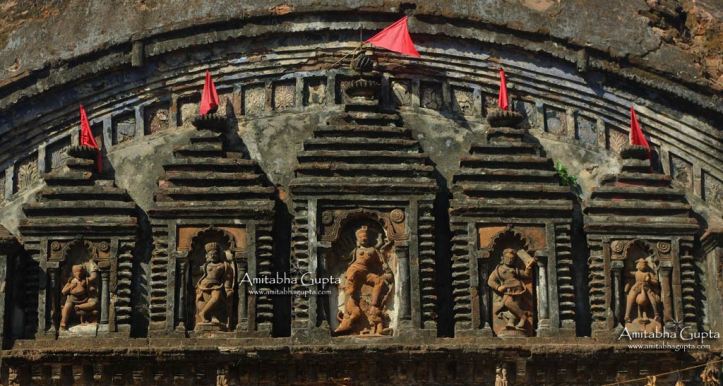
The uniqueness of Durga temple is not limited to its structure. Just above the triple arched entrance, one can see this unique panel featuring Goddess Durga with her family members in other panels. This is perhaps the largest panel of Goddess Durga in terracotta temples. Each idol has a separate shrine made of stucco, which looks like a miniature temple. This is an exception as usually in terracotta panels we see Durga with her family in a single panel. Durga occupies the central shrine, while the other shrines are occupied by Ganesha, Kartick, Saraswati and Laxmi. Saraswati and Laxmi have no Vahana. Instead, they are standing on lotus flowers.

Sadly the Durga Idol is heavily damaged. The lion and the Mahishasur demon cease to exist. Only their hind legs remain. Two hands of the Durga idol are bigger than the other eight. Out of those two, the right arm is half broken. Of the small eight hands only five remains – three of the right-hand side of the idol and two of its left. Durga is in standing in a most aggressive manner. The way she is dressed is not the usual Bengali pattern, but to some extent in the Orissa Style.
The Orissa style of dressing is more evident in the idols of Lakshmi and Saraswati, which still maintain their details. Both the idols stand in Trivanga posture (As seen in the case of an idol of Krishna). The idol on the right of Durga is that of Lakshmi as is evident from the fact that she is holding two buds of lotus with their long stalks in her hand. The stalk on the right is broken. Saraswati may have been holding a musical instrument earlier as is evident from the remains on an object in her left hand.
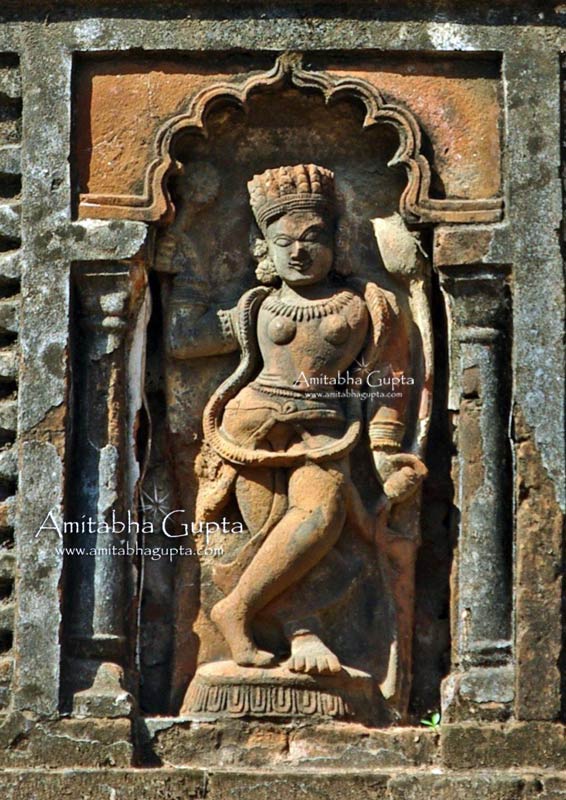
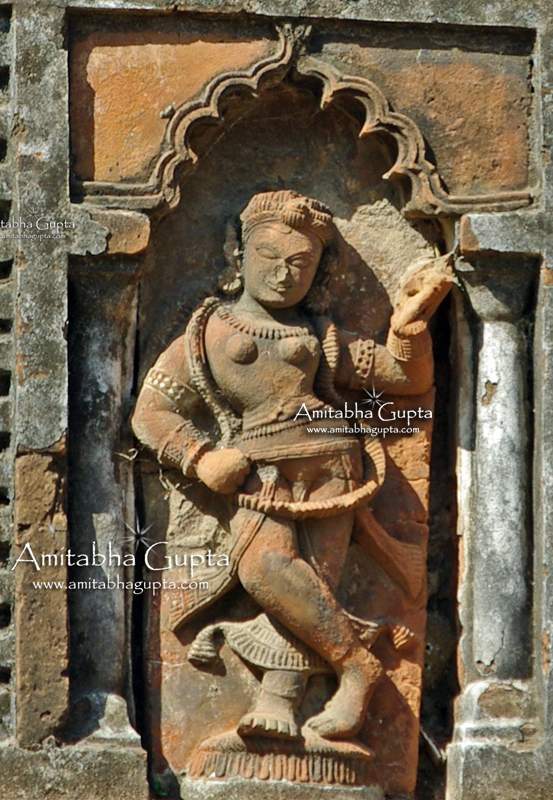
The idol of Ganesh has its right foot broken and that of Kartick both the feet are broken. Only half of Kartick’s bow remains. One of Ganesh’s hand is broken and unlike the other idols his face has lost most of the details.
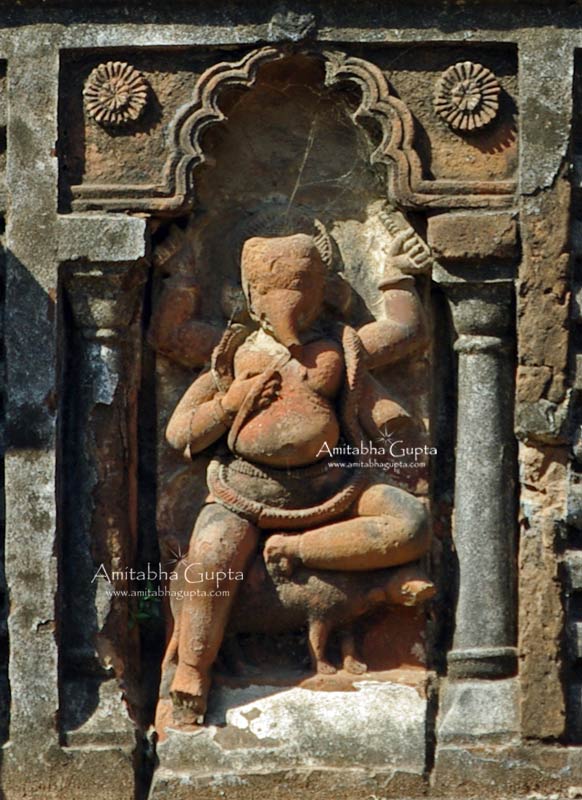
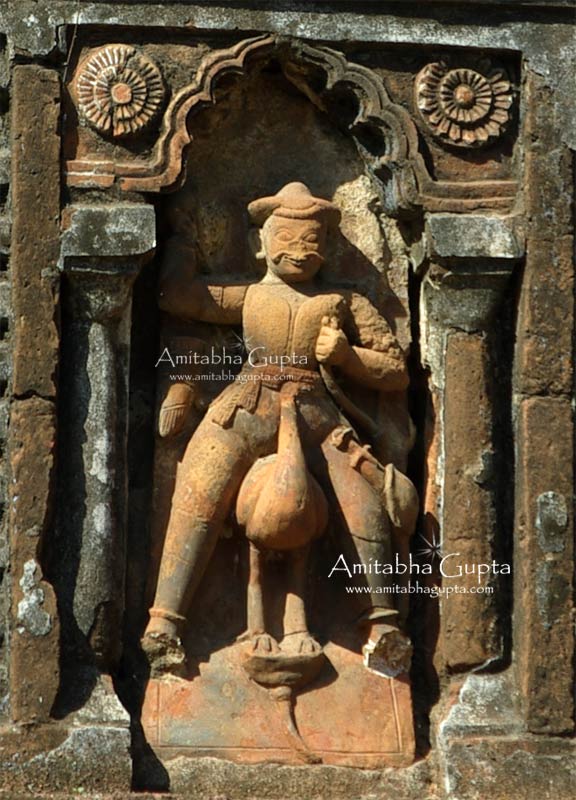
Remaining decorative elements of Durga Temple
Like in many other temples, one of the arched entrances has vertical friezes of superimposed figures of horseback warriors hunting animals or demons on the top portion of its pillars. The figures are damaged. Such vertical friezes can be seen on the walls of temples and locally known as “Mrittu Lata” (Death Creeper). I have seen best examples of such vertical friezes in the Krishna Chandra Temple of Kalna.
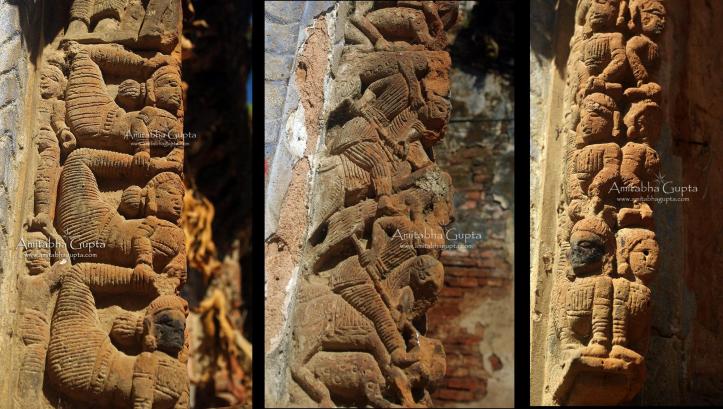
The other entrances have similar vertical friezes, but they are not soldiers. The figures of one such frieze are that of superimposed women lying on their chest and putting up their legs in an unnatural folded fashion. These are actually gymnasts and similar frieze can be seen at Ananta Basudev Temple of Banshberia. In another frieze, there are sitting figures over each other in double vertical columns. The figures look like men, though the faces have been eroded severely by the vagaries of time.
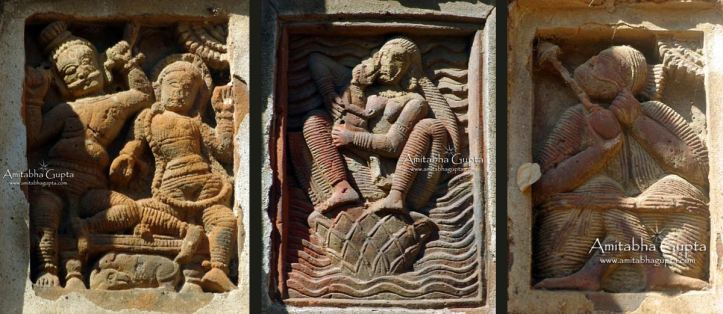
On the two vertical wall panels beside the triple arched entrance, there are some terracotta figures depicting events arranged in vertical fashion within a rectangular frame. Most of them were severely damaged. I could recognise a defaced Kali and an erotic scenario among them. Social scenarios like a man smoking hookah and traditional panels of Shiva and Durga were present. A panel showed Ganga carrying Vishnu as Varaha Avatar (from tales of Vishnu’s Dasavatar). However, these terracotta figurines were crude compared to the ones seen in the Durga Panel. It looked as if a different artist had made these.

The condition of the temple is deteriorating over the years despite being declared as a protected monument by State Archaeology. The walls are getting damaged with the passing of each year.
Other Temples and structures at Balidewanganj
The Durga Temple is located at Rautpara locality of Balidewanganj. The area has several other temples of which maximum are in a totally ruined state. Just beside the Durga temple is the Sarbamangala temple which was once a Pancharatna temple. Sadly enough only the central pinnacle remains. None of its terracotta panels exists. The frontal entrance has broken down since long.
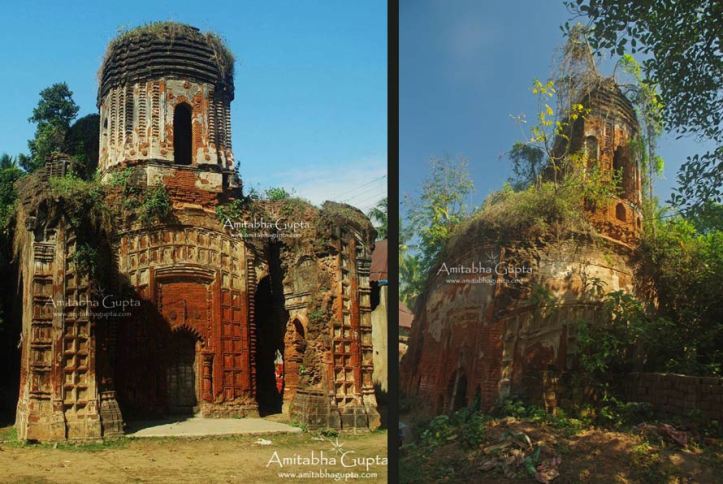
Behind the Sarbamangala temple is the Mangalchandi temple which once had 13 pinnacles. Now it is left with only one. Its pinnacles may have broken down long ago. David J. McCutchion mentioned this temple in his 1972 published book ‘Late Mediaeval Temples of Bengal: Origins and Classification’ as “The ruined richly terracotta-decorated Mangal Chandi temple at BALI (Hooghly: Goghat) is said to have had thirteen turrets)”(P-55). Very few terracotta plaques are left on the temple’s walls.

Opposite to Mangalchandi temple is a brick structure whose exterior is totally ruined and beyond recognition as to what shape it was. A tin shade is fixed on its entrance. A deity is being worshipped in the interiors by the locals. I guessed this may be the Damodar temple as mentioned by David McCutchion in his above mentioned book( P 47). In its present condition, its is not even worth mentioning.

We had encountered a huge abandoned house (looking like a haunted mansion) named Shiv Kutir on our way to the village. Locals say it belonged to one Shib Pal who was zamindar of that area. There is a narrow pathway just after Shiv Kutir on the left, where infested inside the jungle is an abandoned and severely damaged temple with a good amount of terracotta plaques on its wall. It was once a Pancharatna, but only one Ratna is left. The place is difficult to access.

Front View of Shiv Kutir
Driving down the same road after crossing Balidewanganj, ruins of many temples can be seen on both sides of road deep inside the jungle. Apart from the temples I visited could not locate the Damodar Temple of Dalalapara mentioned in both the books of David McCutchion and Nihar Ghosh.
However I did locate one flat roofed (alias Chandni) double storied temple in the village, very close to Rautpara. I have no reference about this temple in any books and so I was surprised to come across it. Just beside the Chandni is a ruined structure and a small Aatchala temple. The Aatchala temple had an almost faded foundation which said 1226. It meant the temple was built in 1819 and may be the flat roofed double storied structure was built in the same time. The temple had some interesting stucco work, beautiful pillars and decorated false windows.

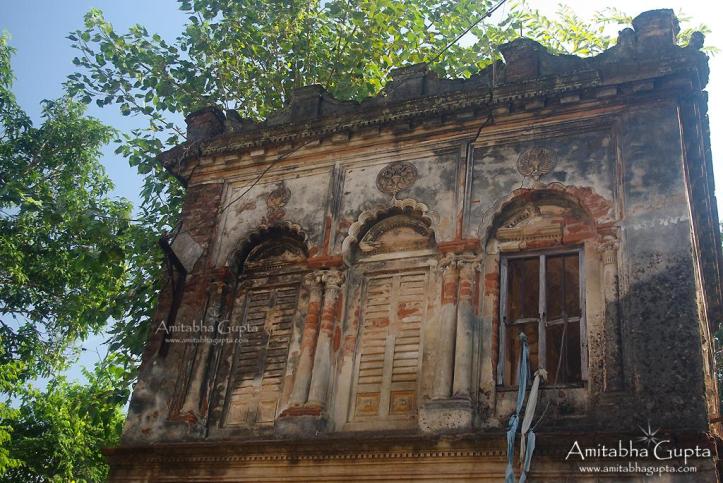
My joy of ‘discovery’ of this structure was short lived as I came to know that the owner plans to destroy the structure soon as it was ‘dangerous’ with children around. He mentioned that slabs and stones fall down regularly from the dilapidated structure. Since he does not have means to repair the temple and he wishes to ‘utilize’ the area, he wants to pull it down.
My friend wanted me to report this matter to the authorities. I refused as I have already seen the most unique brick temple of Bengal lying in utter neglect even after it has been undertaken by the State Archeological Department way back in the 1990s. After two years of my visit to this temple, I doubt how much have changed in its condition.
Update : 31.12.2016
Shib Kutir Interiors
The best time to photograph the interiors of Shiv Kutir is after 12:00 noon during winter. The vegetation is less and light is favourable too. I discovered during my second visit on 25th December 2016 that there are two staircases inside the mansion. Both are risky. However, the first one is accessible and I went even to the second floor. The second one has got a portion broken in the middle. There is a small underground passage which is not at all advisable to venture. This time looking at the interiors, I formed the opinion that this was probably a temple. In all probability, this was a Durga Temple with a huge courtyard. I have seen a similar structure at Kalikapur.

Laxmi Janardan Temple
During my second visit in 2016, I also visited the aforesaid abandoned temple after venturing into the jungle beside the pathway, just after Shib Kutir. At present, it has only one pinnacle whose details cannot be understood due to the trees around it. The temple is almost in a crumbling shape. To my utmost surprise, I found that a portion of its foundation stone still exists. The year of construction does not exist anymore, but the name of this temple is clearly visible. It is Laxmi Janardan. The closest reference I can get is from the books “Hooghly Jelar Purakirti” and “Temple Art of Late Mediaeval Bengal” by Nihar Ghosh from which I can conclude this may be the abandoned Pancharatna temple of Dalalpara built in 1747. David McCutchion in his book “Late Mediaeval Temples of Bengal”( P 45) also mentions a ruined Pancharatna temple ta Bali Dewanganj. However, none mentions the name.
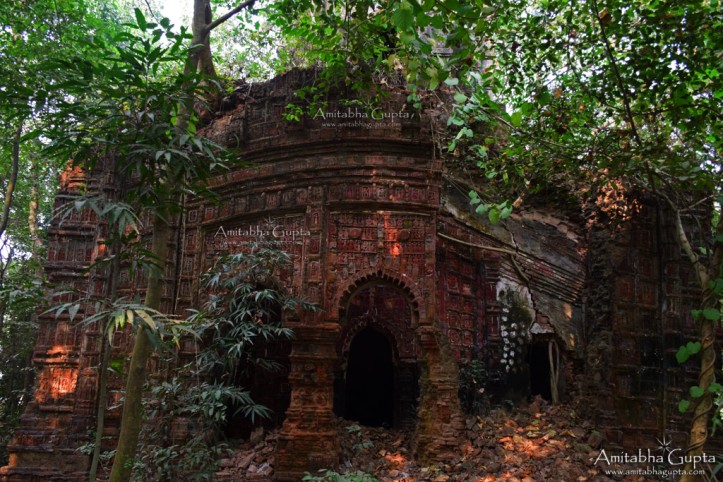

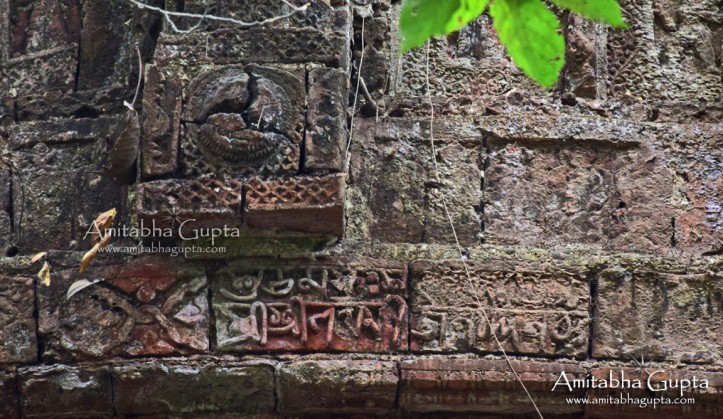
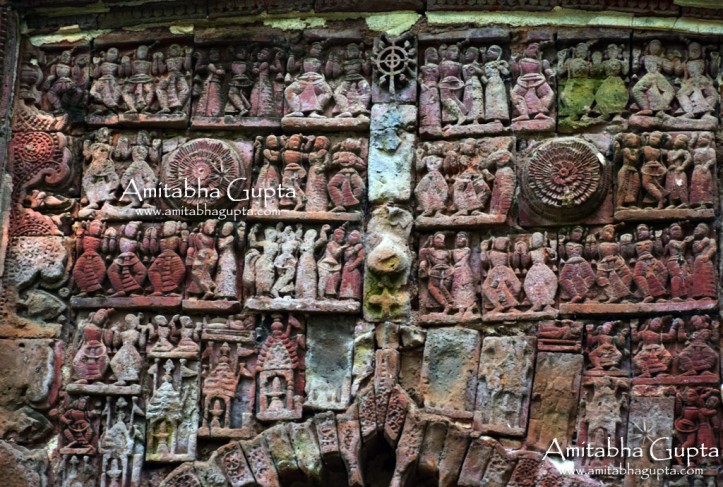

Close up of a terracotta panel on the wall of Laxmi Janardan Temple
Many of the terracotta panels of the temple still exist. The Temple has a triple-arched entrance, over which the foundation stone is visible. The right arch has collapsed. The inner walls also had some intricate terracotta works. It pained me to think that how elegant may the temple have been in its primetime. Interestingly the side of the temple visible from the main road is not its main entrance, but the one on the right or the southern side. The temple has several false doors on its other sides.
Damodar Temple of Ghoshpara
No wonder I could not locate the Damodar Temple on the last visit in 2012. The temple is located at Ghoshpara and not Dalalpara, which is why local people had given me a blank look when I asked them about the Aatchala temple at Dalapara.
Ghoshapara is just about 700 metres from the entrance to Rautpara from the main road. The Temple falls on the right side and is hidden within trees. There is no proper landmark except the fact that almost on the opposite side of the road, there is a long stretch of village pathway.
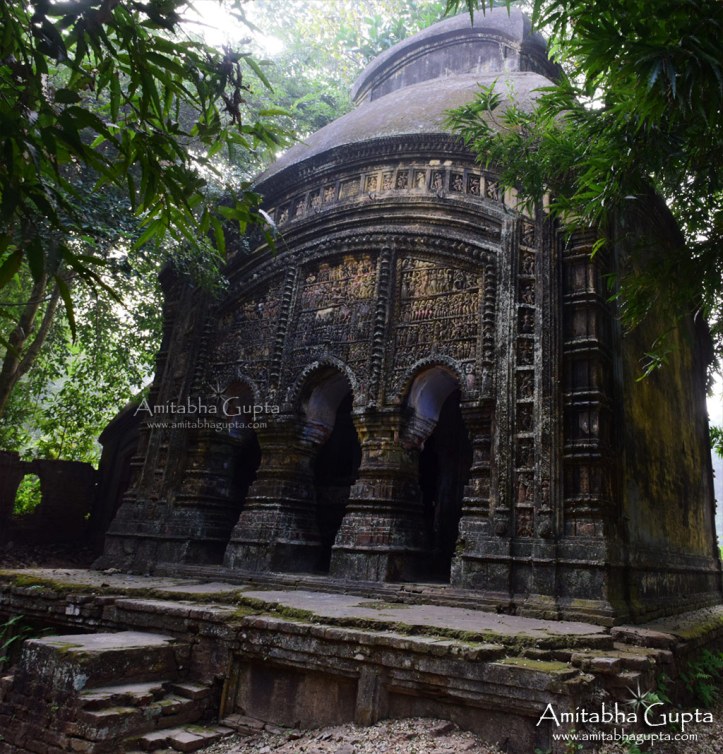
The east facing Aatchala temple belongs to the local Ghosh family. There are other two small Aatchala Shiva temples just adjacent to it. The foundation stone says that the Damodar Temple was built in 1229 Bengali Year, that is in 1822. There is the name of one Ramhari Ghosh, who may have built up this temple. This structure is also not in good shape. It appears from its present condition that once it might have painted crudely in yellow, which have worn off with the passage of time.
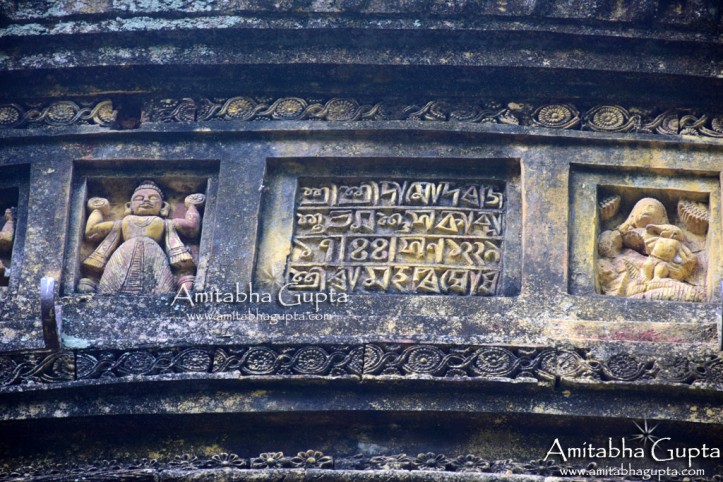

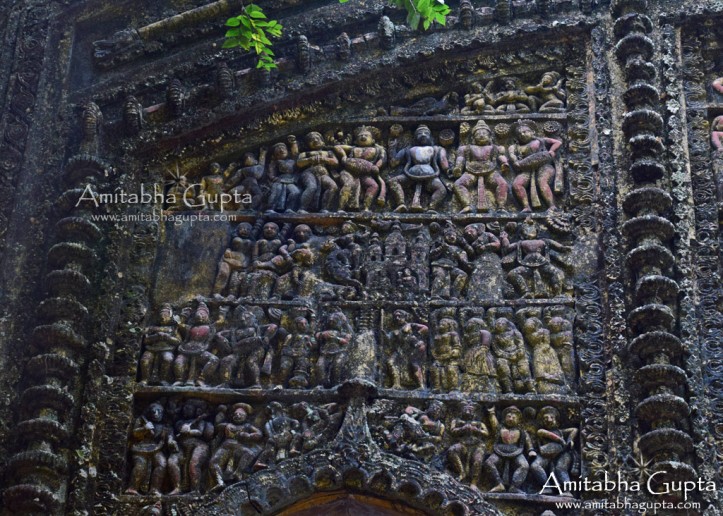

The central arch panel showcases Rama and Sita on the throne with their subjects. Rest of the figures have eroded so badly, that except for some monkeys in the bottom row rest is beyond recognition. The left arch panel has many figures out of which Krishna leaving for Mathura in Akrur’s chariot surrounded by grieving Gopinis is very prominent. The right arch panel depicts several scenes from Krishnalila out of which Krishna Kali and Vastraharan scenarios are very prominent. There are several other terracotta panels which depict among other things Dasavatars of Bishnu.
The Durga Temple of Balidewanganj has still not seen any conservation efforts during my last visit on 25.12.2016. The date tree beside the temple has been struck down by lightning. Thank God it did not hit the tempIe. I really do not know when there will be any conservation effort. I did not see any State Archeology signboard in 2012. That scenario has not changed. Yet there is no State Archeology signboard till date , despite this being a State protected monument.
But one good thing is that two storied temple structure still remains. It has not been demolished by its owner.
How to go to Bali Dewanganj
By local transport
Though there are direct train and buses to Armabagh from Kolkata, it is best to take the Tarakeswar local from Howrah and get off at Tarakeswar. There is direct bus service to Bali Dewanganj which is around two hour’s journey. The bus stop is known as Haldarpara. From there you have to walk a bit and take a turn to the left beside a Tea stall. The road to Routpara is a winding one with jungle type vegetation around. You will land in front of a pond with lots of houses. From the pond, a narrow lane on the left takes you to the temples.
By Car
Drive to Arambagh from Kolkata. Take a left turn after crossing Arambagh Railway station and cross the bridge over Dwarakeshwar river. You will get three roads after crossing the bridge. The straight one goes to Jayrambati- Kampurpukur. The one on the right heads towards Bishnupur and the road on the left heads to Bali Dewanganj. You will need to drive for at least 30 minutes before you reach the village after encountering “Shiv Kutir” and the Rasmancha on the way. You have to drive straight to reach Shiv Kutir except for a left-hand turn at Natunbazar. There is a sweet shop as well as two shop side by side name Bapi Jewellers and Matri Tailors. I am sharing here the photograph of the Rasmancha. It is an octagonal structure with some figures.
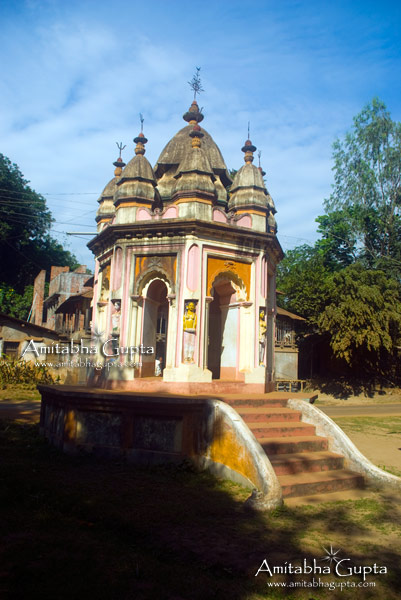
Earlier there was no landmark to the lane on the left taking you to the village, except a tea shop. But now driving a bit ahead you will get a freshly painted two-storied house on the left with a huge wall advertisement of Manna jewellers. I am sharing that too. Drive into the lane beside that to reach Rautpara. The car will not go the entire way. You will have to park the car after crossing the double storied temple beside a dried up pond. You have to walk a bit through a narrow village path to reach the temples.

Where to Eat
There is actually no eateries at Bali Dewanganj except that sweets shop at Natunbazar. Mineral water is available there too. There are decent eateries at Tarakeshwar and Arambagh. For Arambagh, Bhuri Bhoj restaurant opposite Rabindra Bhawan near SD hospital is an excellent choice for both vegetarian and non-vegetarian. Carry water as you will not get proper drinking water in the village.
Location in Google Map
Entrance of Bali Dewanganj Road
Special Thanks
1. Rangan Datta for providing suitable guidance for navigating the place
2. Anirban Datta for accompanying me to Bali Dewanganj
3. Banani Bhattacharya for deciphering some terracotta panels
4. Deepanjan Ghosh for accompanying me to Bali Dewanganj for the second time.
References
1. Hooghly Jelar Purakirti by Narendra Nath Bhattacharya. Published by Information and Cultural Department, Government of West Bengal, August 1993
2. Terracotta Temples of Bengal by S.S. Biswas and Zulekha Haque. Published by Friendship Publishers, 1995
3. Late Mediaeval Temples of Bengal : Origin and Classifications by David. J. McCutchion. Published byThe Asiatic Society Kolkata, July 1972
4. Temple Art of Late Mediaeval Bengal by Nihar Ghosh. Published by Suchetna , January 2006
5. Kolkatar Mandir – Masjid : Sthapotto-Alankaran-Rupantar by Tarapada Santra. Published by Ananda Publishers, April 2002
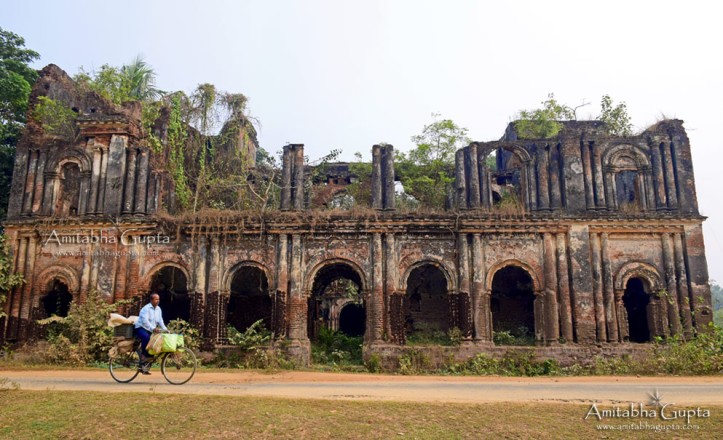

Good to read a post from you after a looooong time. As usual your posts are unique and well researched. Before reading this post I considered all terracotta temple as same… this post enlightened me on their variety…keep posting such wonderful posts more often
Thanks. Good to know you liked it. Will try to overcome my laziness and write more blog posts.
I have no words about your initiative. It’s my long desire to take a series of archives about our Bengal heritage and architecture. It is my proud privilege to be a part of your journey. Your semaphore-related information is very helpful for me. i am also trying to find out a little bit about that. ai bangla ananta ratna bhander stapatter. keep it up daya kore ai poth theke sorben na. keu nei je er mullo bojhe.
Posted the URL in FB
Thanks.
Wonderful coverage. Next time I visit Kolkata, I will definitely visit Jora-Bangla Temple.
Please continue documenting historical icons like Jora-Bangla Temple. It is educational to persons like me who left Kolkata many years ago for pursuit of higher education and never returned back.
Good to know you liked it
Your blog is very informative, meaningful and to the point. Being a travel blogger I find you have a very good writing sense due to which you explain details about many destinations perfectly, Your blog is like books of Lonely planet for a various travel destination. If someone required destination information your blog is enough instead of searching anywhere. Keep it up to your meaningful blog writing.
Travel Blog
Wow.. thanks a lot !
Jamalpur, Paschim Bardhaman towards Shyamsundar road there is a semaphore in the middle of the paddy field.
Chances of having a semaphore tower in that area is less as no semaphore line passed through that area. It might be a GTS Tower. Could you mail me it’s photo?